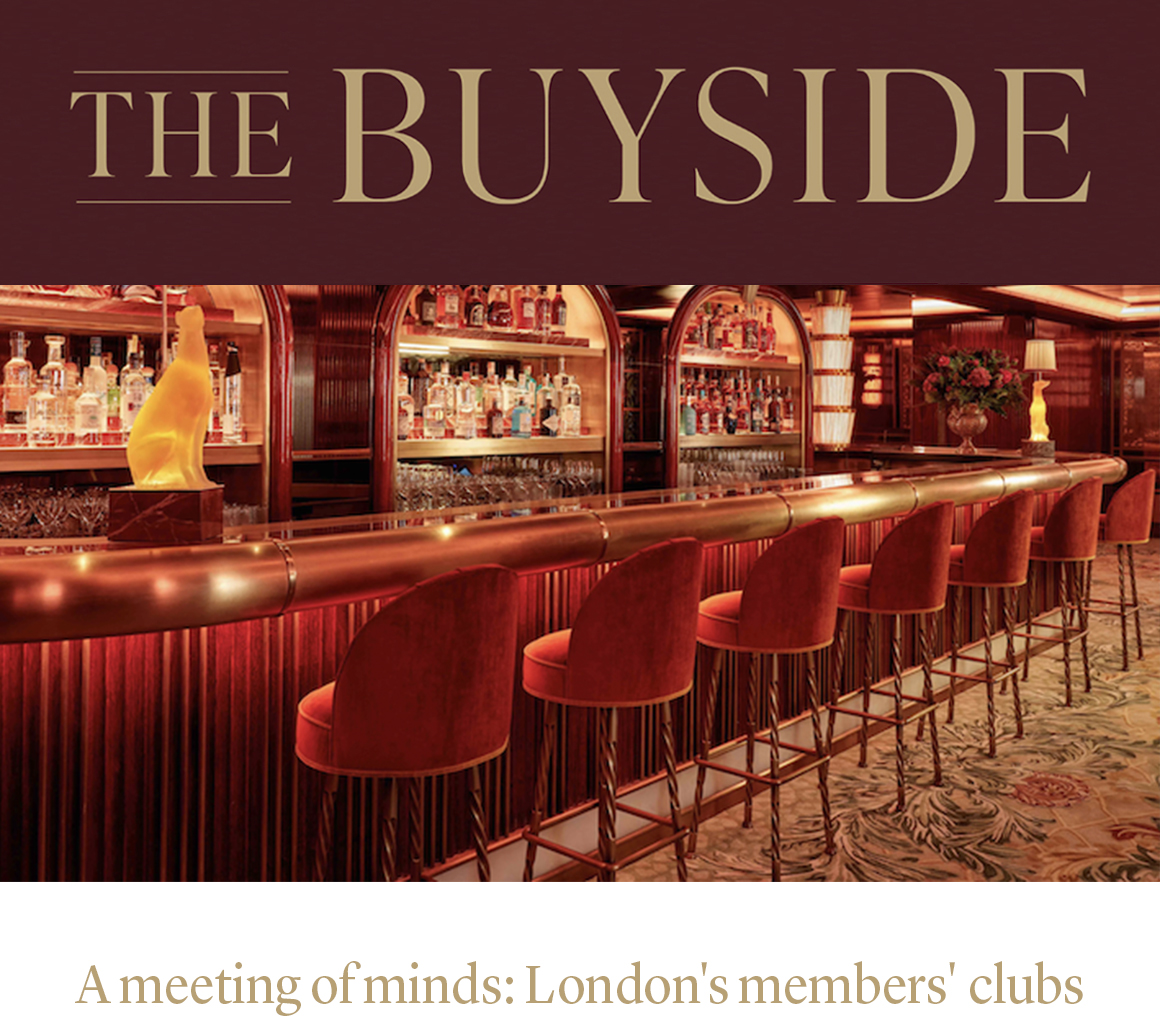
We welcome the recent re-opening of George in Mayfair, which has long been enjoyed as a favoured breakfast meeting spot for the firm’s founders Richard and Sophie. Sharing news and discussing ideas within the art-decked walls of George’s formal but intimate setting has been a regular part of RFR’s weekly rhythm. Alongside Mark’s Club, Annabel’s, Harry’s Bar and the Bath & Racquets Club, George makes up one fifth of The Birley Clubs group, led by Richard Caring whose monopoly of members’ clubs and restaurants spans Mayfair and St James’s. The club’s re-vamp has prompted us to delve into the history of London’s members’ clubs: their founding principles, distinct characters, architectural aspirations, and to understand their presence and relevance within London society today.
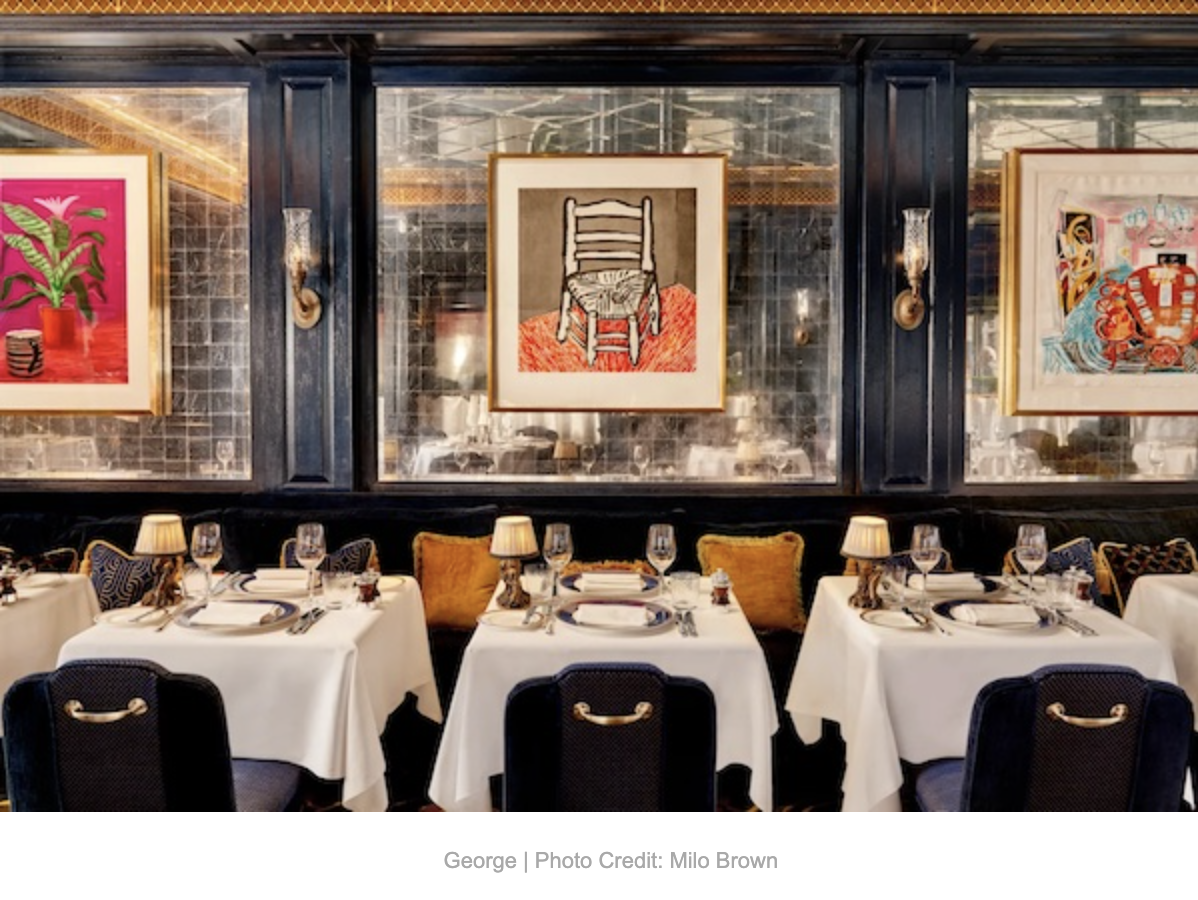
The origins of London’s gentlemen’s clubs
Following their coffee house predecessors in the 17th century, the rise of London’s gentlemen’s clubs began with White’s in St James’ Street, founded in 1693, with Brook’s and Boodles following suit. As an escape from the chaotic throng of city life, they were intended as exclusive, secluded spaces designed for refuelling and recharging amongst kindred spirits. The clubs often had divergent focuses, drawing in like-minded crowds with shared principles and outlooks, whether in politics, literature, sport, art or travel. “The diplomats would mingle at the St James Club, artists and impresarios could be found hobnobbing at the Garrick and politicians would network at the Carlton or the Reform Club” observed Suyin Haynes in Time Magazine.
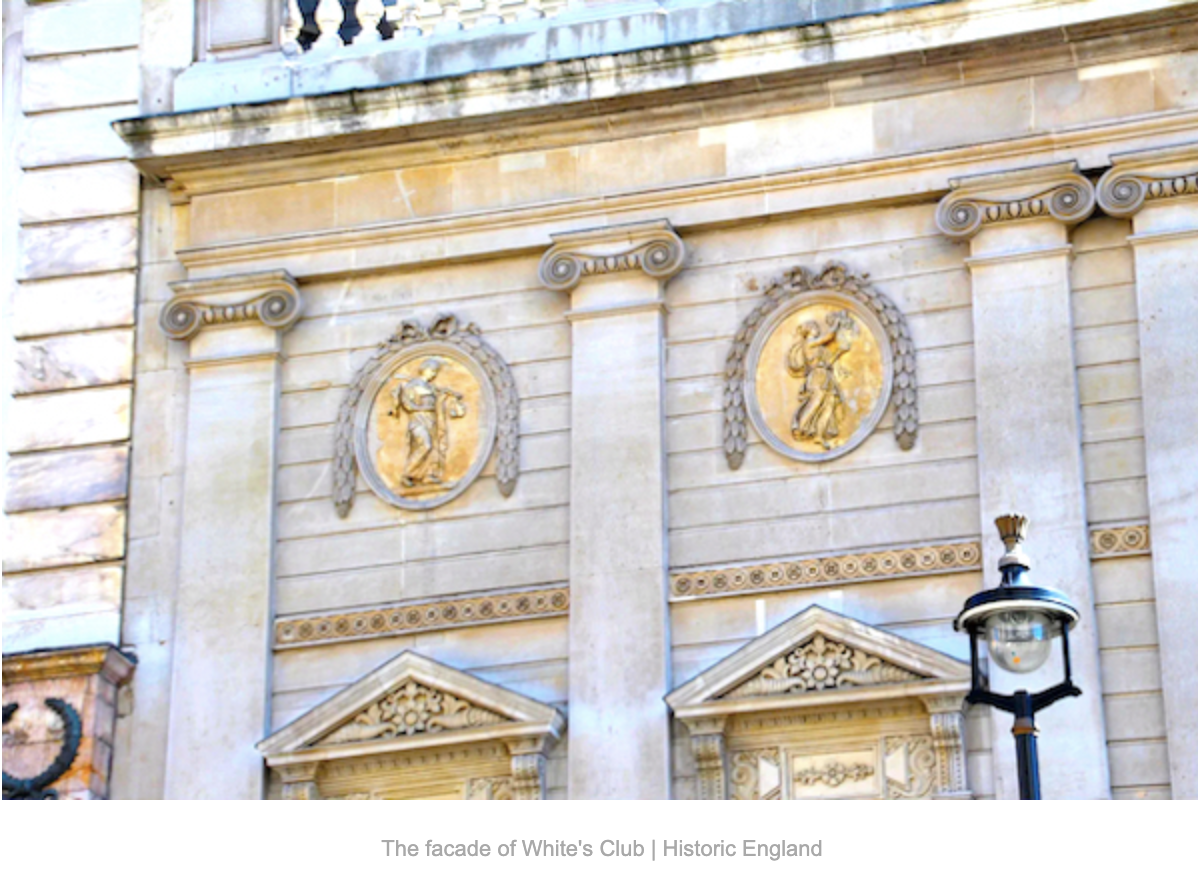
Palladian appeal
Designed to cater for members’ domestic needs, the clubs typically featured a dining hall, library, games room, bedrooms and washrooms. Often set in significant Palladian mansions, the opportunity to partially reside in these architecturally important buildings with elaborate entrances was also a major draw. Debrett’s ‘A History of Private Members’ Clubs’ article noted that many of the London sites were “frequently located in grandiose, lavish buildings, providing luxurious and comfortable surroundings, which created a sense of the club being a ‘home from home’”. The oldest, White’s, was originally built in 1674 and then rebuilt in 1787-88, likely by architect James Wyatt. The five-storey premises featured the Victorian version of a Palladian façade with ornate French motifs. Similarly, Brook’s, designed by architect Henry Holland in 1778, was built in yellow brick and Portland stone in the Palladian style, featuring neoclassical-style interiors, many of which still exist today.
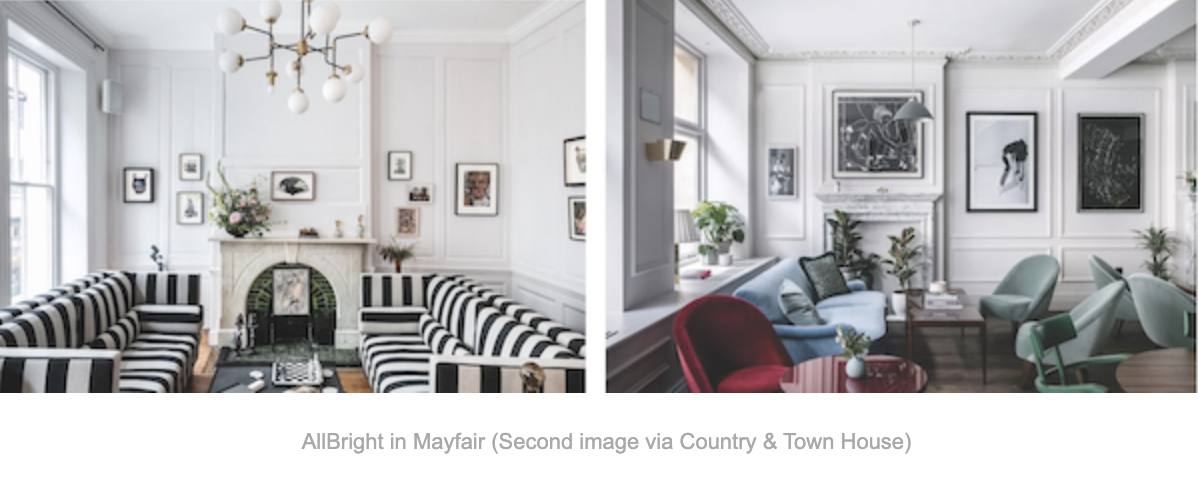
The emergence of Women’s Clubs
Women’s clubs entered London in 1884 with The Alexandra in Mayfair leading the charge. Launched shortly after in 1892 and located on Regent’s Street, The Pioneer Club, named after a poem by Walt Whitman, was a progressive women’s club founded by women’s rights campaigner Emily Massingberd. The Empress Club, inaugurated by Queen Victoria, was founded in 1897 on Dover Street, featuring two vast drawing rooms, one in a Venetian style. The Bath Club, a sports-themed club established in 1894 next door at 34 Dover Street, was one of the few clubs to admit women – albeit through a different entrance – and is where Princess Margaret and Queen Elizabeth II learnt to swim. The Sloane Club in Chelsea originally opened in 1922 as the Service Women’s Club to welcome female officers of the Armed Forces in World War II, before opening its doors to men as well in 1976.
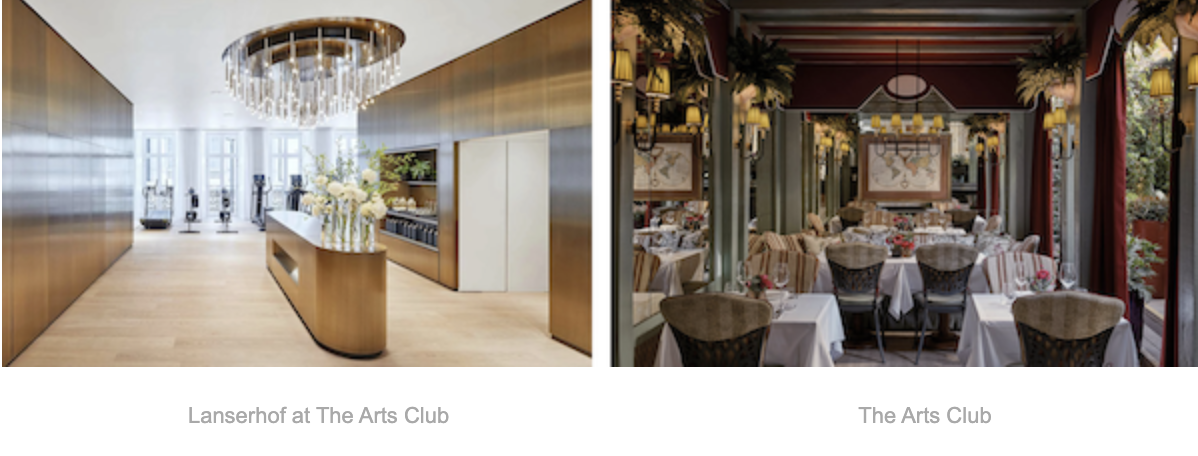
Contemporary Clubs
There’s an eclectic mix of vibrant members clubs across London today, with new spaces opening regularly, seemingly in constant competition to out-do their predecessors in capturing the zeitgeist of the day! Both contemporary and historic clubs continue to offer a sanctuary from the hectic demands of London, although many also bring their own energy and vibrancy to the fore. Indeed, for a while, and with fewer clubs providing lodgings or resting spaces, it seemed the onus had shifted completely towards good food, good wine and good times. However, in recent years, there has been a notable focus on wellbeing, providing an antidote to members’ living high-pressured urban lives. Lanserhof, at The Arts Club in Mayfair, is the first ‘medi-gym’ in the world and the only UK destination to offer Lanserhof’s treatments through a team of trainers, therapists, medics and high-tech diagnostic equipment. Family-focused spaces have also emerged in recent years to include Cloud Twelve in Notting Hill, B-Together in St John’s Wood, and Jaego’s House in Kensal Rise.
There has also been a resurgence in all-female clubs including AllBright, based in Mayfair, connecting ‘smart-minded women’ at any stage in their careers in a setting that features artworks by female-only artists. Women’s networking club Chief originated in the US and recently launched in a Bloomsbury townhouse with its homely, cosy aesthetic designed by Thirdway, whilst The Trouble Club hosts a rotation of dinner and culture clubs with exclusively female guest speakers that cover predominantly politics and fiction. Women’s-only members health club Grace Belgravia, co-founded by Sophie’s mother Kate Percival in 2012, and located in a Grade II listed townhouse, was a calming and elegant sanctuary to escape the demands of city life, and a pioneer of the wellbeing trend.
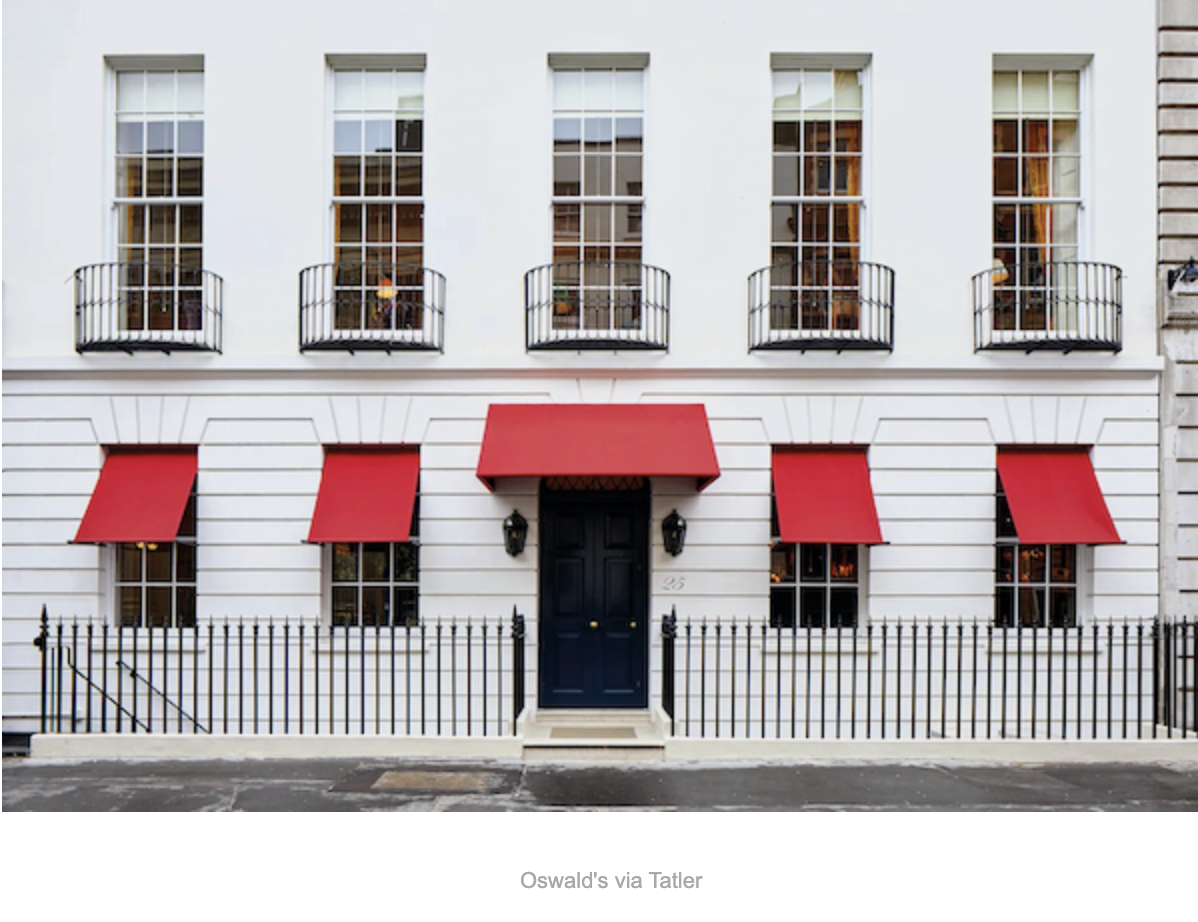
Innovative interiors within historical architecture
Club owners continue to draw on London’s historic and architecturally important buildings to lure the most discerning members, with global interior designers being drafted in to put their creative powers to good use and out-manoeuvre the competition. Behind a discreet entrance in Mayfair, the impeccable interiors of 5 Hertford Street – the vision of designer Rifat Ozbek – imbues a charming English country house feel filled with esoteric pieces. Oswald’s, which is also one of Robin Birley’s sites alongside 5 Hertford Street, opened in 2018 with the interior featuring Murano chandeliers, columns and high ceilings designed by Tom Bell and Bruce Cavell, to create an otherworldly impact.
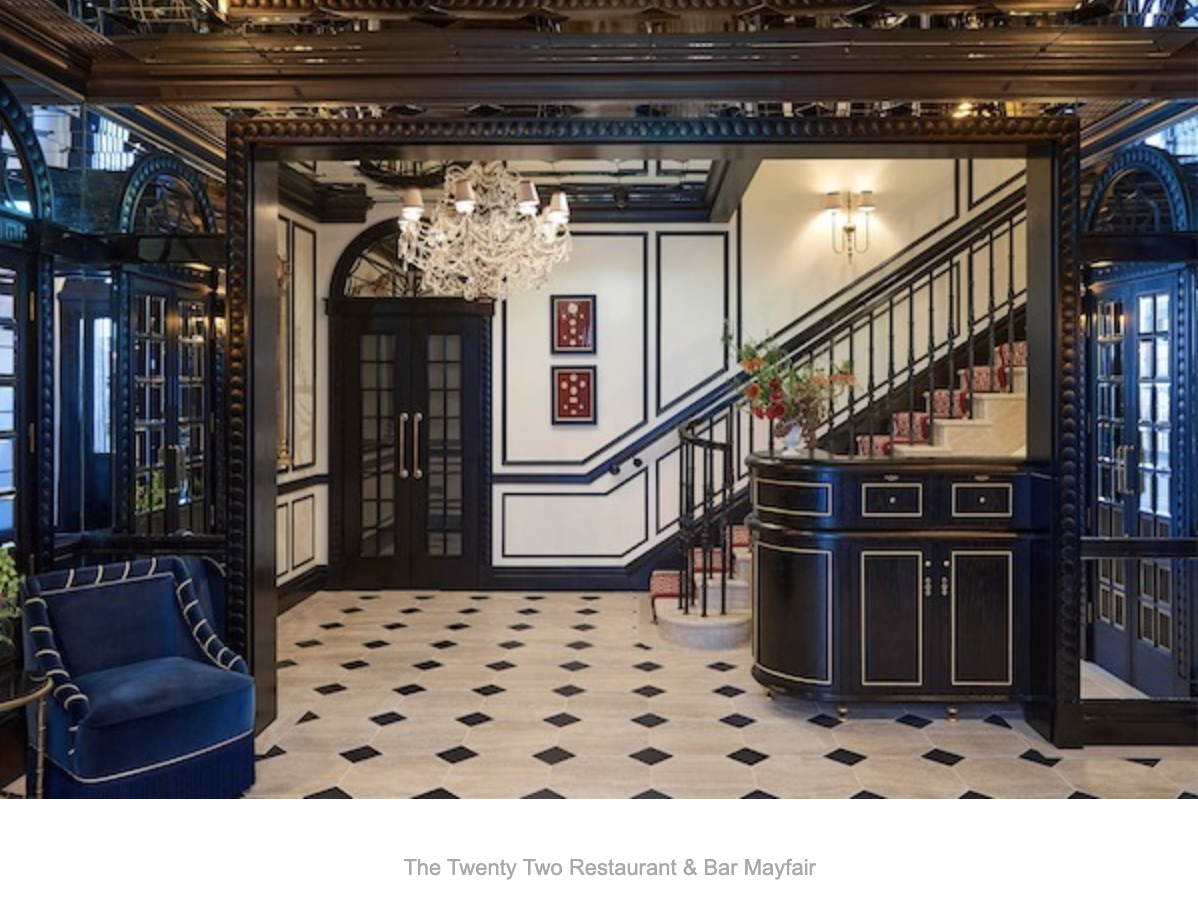
Over on Grosvenor Square, The Twenty Two, ‘designed for the creative and the curious’, opened last year in a storied Edwardian manor with Natalia Miyar’s decadent and maximalist interior design scheme inspired by 18th century France in tribute to the ‘grandeur of this former family home’.
Then, of course, the spread of Soho House sites across the city, which include 76 Dean Street, a Grade II listed 18th century townhouse, 40 Greek Street set within a Grade II listed townhouse and 180 House set in a Brutalist landmark where the Strand and Fleet Street meet. Whilst their distinctive architectural styles differ, the quintessential ingredient of the Soho House ‘look’ is threaded throughout: an array of artwork that champions emerging talent alongside layered textures and patterns, plush velvet seating and its signature earthy tones.
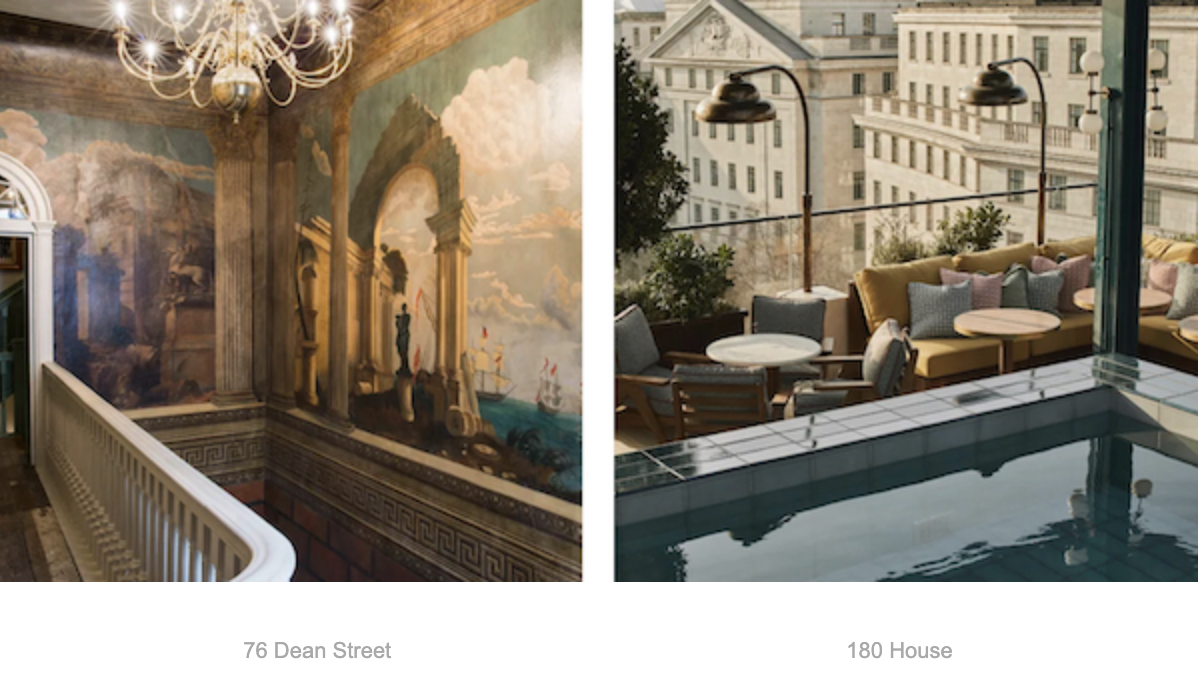
Smart thinking: a rise in work spaces
The Carrington, the latest venture by Robin Birley, pledges to ‘create the ultimate work space’ in his next business-focused members club venture. Located opposite 5 Hertford Street, it will remain open 24/7, 365 days a year with IT specialists, secretarial and financial analysts available at all times.
Already up and running, Home Grown in Marylebone is a place for ‘entrepreneurial pioneers’ to nurture and launch their visions, bringing together a ‘global community of visionary entrepreneurs, investors and business leaders’ through events, seminars and breakfast briefings. Similarly, Soho Works offers a plethora of places designed for ‘businesses and creative thinkers to come together and share ideas’ across four of its London sites.
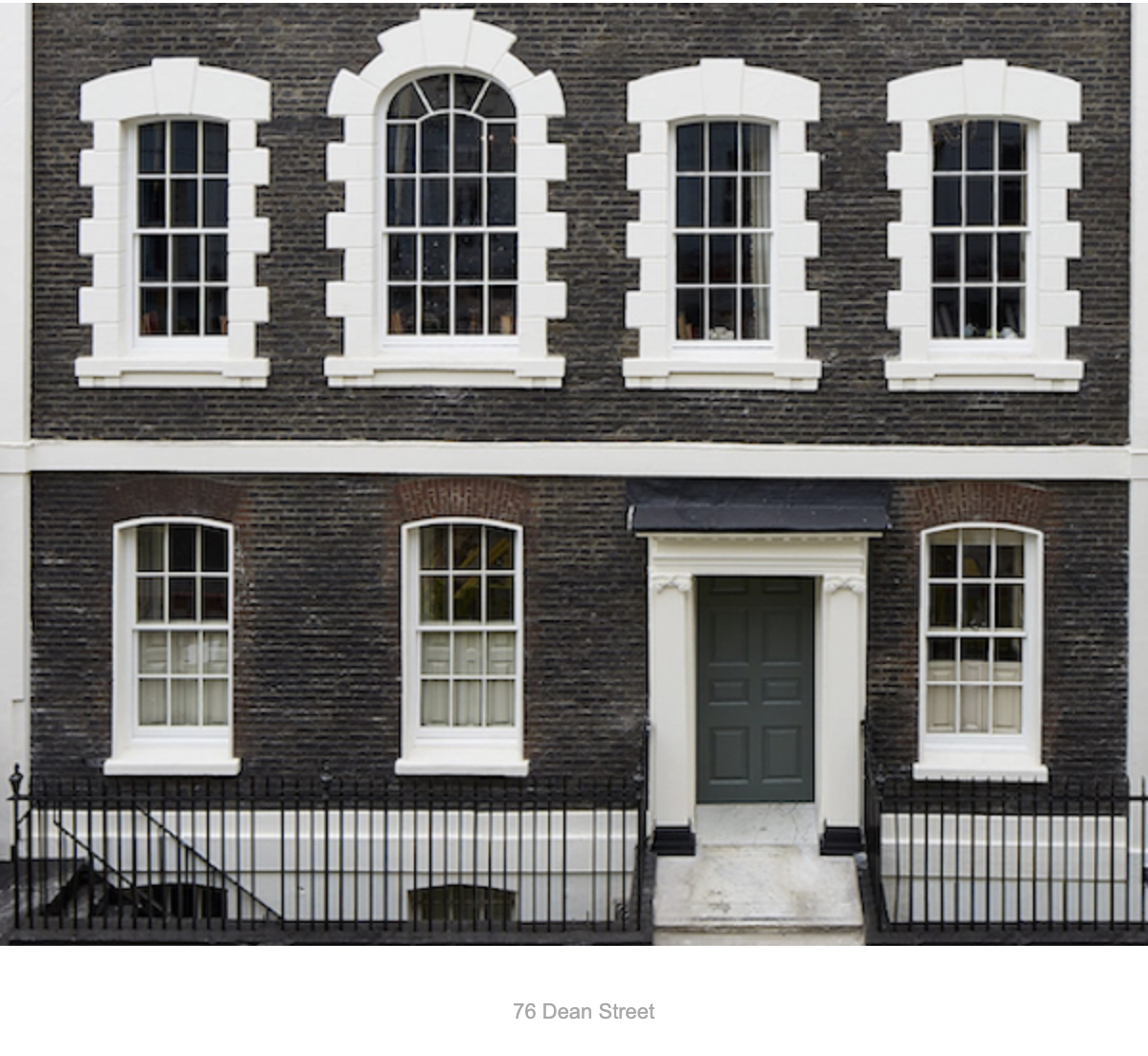
With a smorgasbord of business, arts, wellness, music, sports and environmental-focused clubs to keep people occupied, the popularity and energy of London’s members clubs shows no signs of waning! In many ways, the quality, vibrancy and innovation showcased by so many of these special establishments, reflect why London remains such a relevant and aspirational city for so many international clients.
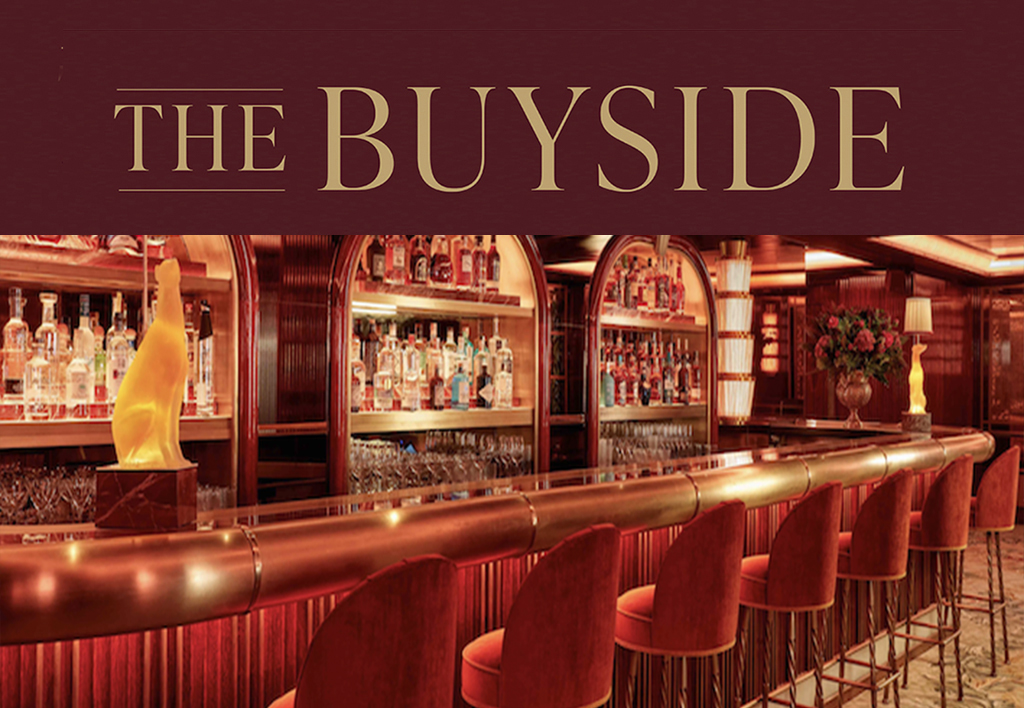
A meeting of minds: London’s members’ clubs
We welcome the recent re-opening of George in Mayfair, which has long been enjoyed as a favoured breakfast meeting spot for the firm’s founders Richard and Sophie. Sharing news and discussing ideas within the art-decked walls of George’s formal but intimate setting has been a regular part of RFR’s weekly rhythm. Alongside Mark’s Club, Annabel’s, Harry’s Bar and the Bath & Racquets Club, George makes up one fifth of The Birley Clubs group, led by Richard Caring whose monopoly of members’ clubs and restaurants spans Mayfair and St James’s. The club’s re-vamp has prompted us to delve into the history of London’s members’ clubs: their founding principles, distinct characters, architectural aspirations, and to understand their presence and relevance within London society today.

The origins of London’s gentlemen’s clubs
Following their coffee house predecessors in the 17th century, the rise of London’s gentlemen’s clubs began with White’s in St James’ Street, founded in 1693, with Brook’s and Boodles following suit. As an escape from the chaotic throng of city life, they were intended as exclusive, secluded spaces designed for refuelling and recharging amongst kindred spirits. The clubs often had divergent focuses, drawing in like-minded crowds with shared principles and outlooks, whether in politics, literature, sport, art or travel. “The diplomats would mingle at the St James Club, artists and impresarios could be found hobnobbing at the Garrick and politicians would network at the Carlton or the Reform Club” observed Suyin Haynes in Time Magazine.

Palladian appeal
Designed to cater for members’ domestic needs, the clubs typically featured a dining hall, library, games room, bedrooms and washrooms. Often set in significant Palladian mansions, the opportunity to partially reside in these architecturally important buildings with elaborate entrances was also a major draw. Debrett’s ‘A History of Private Members’ Clubs’ article noted that many of the London sites were “frequently located in grandiose, lavish buildings, providing luxurious and comfortable surroundings, which created a sense of the club being a ‘home from home’”. The oldest, White’s, was originally built in 1674 and then rebuilt in 1787-88, likely by architect James Wyatt. The five-storey premises featured the Victorian version of a Palladian façade with ornate French motifs. Similarly, Brook’s, designed by architect Henry Holland in 1778, was built in yellow brick and Portland stone in the Palladian style, featuring neoclassical-style interiors, many of which still exist today.

The emergence of Women’s Clubs
Women’s clubs entered London in 1884 with The Alexandra in Mayfair leading the charge. Launched shortly after in 1892 and located on Regent’s Street, The Pioneer Club, named after a poem by Walt Whitman, was a progressive women’s club founded by women’s rights campaigner Emily Massingberd. The Empress Club, inaugurated by Queen Victoria, was founded in 1897 on Dover Street, featuring two vast drawing rooms, one in a Venetian style. The Bath Club, a sports-themed club established in 1894 next door at 34 Dover Street, was one of the few clubs to admit women – albeit through a different entrance – and is where Princess Margaret and Queen Elizabeth II learnt to swim. The Sloane Club in Chelsea originally opened in 1922 as the Service Women’s Club to welcome female officers of the Armed Forces in World War II, before opening its doors to men as well in 1976.

Contemporary Clubs
There’s an eclectic mix of vibrant members clubs across London today, with new spaces opening regularly, seemingly in constant competition to out-do their predecessors in capturing the zeitgeist of the day! Both contemporary and historic clubs continue to offer a sanctuary from the hectic demands of London, although many also bring their own energy and vibrancy to the fore. Indeed, for a while, and with fewer clubs providing lodgings or resting spaces, it seemed the onus had shifted completely towards good food, good wine and good times. However, in recent years, there has been a notable focus on wellbeing, providing an antidote to members’ living high-pressured urban lives. Lanserhof, at The Arts Club in Mayfair, is the first ‘medi-gym’ in the world and the only UK destination to offer Lanserhof’s treatments through a team of trainers, therapists, medics and high-tech diagnostic equipment. Family-focused spaces have also emerged in recent years to include Cloud Twelve in Notting Hill, B-Together in St John’s Wood, and Jaego’s House in Kensal Rise.
There has also been a resurgence in all-female clubs including AllBright, based in Mayfair, connecting ‘smart-minded women’ at any stage in their careers in a setting that features artworks by female-only artists. Women’s networking club Chief originated in the US and recently launched in a Bloomsbury townhouse with its homely, cosy aesthetic designed by Thirdway, whilst The Trouble Club hosts a rotation of dinner and culture clubs with exclusively female guest speakers that cover predominantly politics and fiction. Women’s-only members health club Grace Belgravia, co-founded by Sophie’s mother Kate Percival in 2012, and located in a Grade II listed townhouse, was a calming and elegant sanctuary to escape the demands of city life, and a pioneer of the wellbeing trend.

Innovative interiors within historical architecture
Club owners continue to draw on London’s historic and architecturally important buildings to lure the most discerning members, with global interior designers being drafted in to put their creative powers to good use and out-manoeuvre the competition. Behind a discreet entrance in Mayfair, the impeccable interiors of 5 Hertford Street – the vision of designer Rifat Ozbek – imbues a charming English country house feel filled with esoteric pieces. Oswald’s, which is also one of Robin Birley’s sites alongside 5 Hertford Street, opened in 2018 with the interior featuring Murano chandeliers, columns and high ceilings designed by Tom Bell and Bruce Cavell, to create an otherworldly impact.

Over on Grosvenor Square, The Twenty Two, ‘designed for the creative and the curious’, opened last year in a storied Edwardian manor with Natalia Miyar’s decadent and maximalist interior design scheme inspired by 18th century France in tribute to the ‘grandeur of this former family home’.
Then, of course, the spread of Soho House sites across the city, which include 76 Dean Street, a Grade II listed 18th century townhouse, 40 Greek Street set within a Grade II listed townhouse and 180 House set in a Brutalist landmark where the Strand and Fleet Street meet. Whilst their distinctive architectural styles differ, the quintessential ingredient of the Soho House ‘look’ is threaded throughout: an array of artwork that champions emerging talent alongside layered textures and patterns, plush velvet seating and its signature earthy tones.

Smart thinking: a rise in work spaces
The Carrington, the latest venture by Robin Birley, pledges to ‘create the ultimate work space’ in his next business-focused members club venture. Located opposite 5 Hertford Street, it will remain open 24/7, 365 days a year with IT specialists, secretarial and financial analysts available at all times.
Already up and running, Home Grown in Marylebone is a place for ‘entrepreneurial pioneers’ to nurture and launch their visions, bringing together a ‘global community of visionary entrepreneurs, investors and business leaders’ through events, seminars and breakfast briefings. Similarly, Soho Works offers a plethora of places designed for ‘businesses and creative thinkers to come together and share ideas’ across four of its London sites.

With a smorgasbord of business, arts, wellness, music, sports and environmental-focused clubs to keep people occupied, the popularity and energy of London’s members clubs shows no signs of waning! In many ways, the quality, vibrancy and innovation showcased by so many of these special establishments, reflect why London remains such a relevant and aspirational city for so many international clients.

